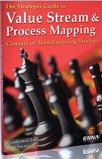|
 Lean
Manufacturing and traditional accounting conflict in several ways. These conflicts often produce
considerable difficulties. The roots of this problem lie, largely, in the history of accounting.
Johnson and Kaplan's book, Relevance Lost,
has much useful background. This page begins our series on Accounting and metrics. It introduces
some of the most important accounting-related issues. Lean
Manufacturing and traditional accounting conflict in several ways. These conflicts often produce
considerable difficulties. The roots of this problem lie, largely, in the history of accounting.
Johnson and Kaplan's book, Relevance Lost,
has much useful background. This page begins our series on Accounting and metrics. It introduces
some of the most important accounting-related issues.
Product Costing
Traditional accounting systems track total expenditures well and are accurate in this.
Determining the true costs of individual products and components is another matter.
The primary culprit in distorted product costs is overhead allocation and the primary effect
is to undervalue many products and overvalue others. This, in turn, causes managers to make
products that could better be outsourced. It also causes under pricing of products that actually
lose money.
Activity Based Costing (ABC)
Activity Based Costing attempts to identify the factors that truly drive overhead cost. It
then allocates overhead costs with formulae that reflect these "cost drivers". For example, in
Purchasing, the activity cost probably relates to the number of line items on the BOM for each
product. In Engineering it might relate to the number of engineering changes.
In practice ABC systems are often implemented in complex ways and produce as much confusion
as accuracy. Glen Navis' article on Volume Adjusted Costing discusses this and offers a simple
alternative for some situations.
Inventory Cost Analysis
While conventional systems often track inventory well, they rarely track the
cost of holding it very well. These costs
include space, warehouse personnel, insurance, utilities and many other costs. Most of these
costs fall into overhead accounts and appear in oversimplified overhead allocation schemes.
They are much higher than is commonly recognized.
|
Micro Costing
In many firms the accounting system integrates with production control, scheduling and
inventory systems via MRP or ERP. These systems are often setup to collect time and cost at each
individual machine and operation. The assumption is that the more detailed the data collection,
the more knowledge is available. This errs on two counts.
-
When data collection becomes a burden, people fake the data, fail to update, or
manipulate it.
-
Data is not knowledge, let alone understanding. Often there is so much data that it is
difficult to interpret.
A preoccupation with detailed machine-by-machine data does not fit well in a
workcell. In cells, one operator may do
many operations on a single part, several operators may also work on a single part. Operators
may switch tasks in midstream. Finally, different parts often move through one at a time in
unpredictable sequences.
The inability to collect detailed data in a manufacturing cell is sometimes a roadblock to
implementation. But all this data collection is non-value added activity and, in workcells,
unnecessary.
Non-Financial Metrics
The foremost goal of business is usually profit. Other goals such as growth, future
profitability, and future competitiveness follow closely behind. The volatile nature of the
present business environment requires people, systems and organizations that cope effectively
with change. But, Traditional accounting does not effectively measure investment in these longer
range objectives.
Profit measures are the end result of a long string of activities that create and market the
products. These profit measures, alone, are inadequate to control and manage upstream
activities.
Running a business for the long term requires more than financial metrics. Individual
activities, processes and parameters within each activity or process step require metrics that
are, mostly, non-dollar units.
Robert S. Kaplan, David P. Norton, in their book,
"The Balanced Scorecard" show how to
link metrics and strategy. They provide a system for investing in customers, employees, new
product development, and in systems-- not just pumping up short-term earnings with myopic
maneuvers.
|





